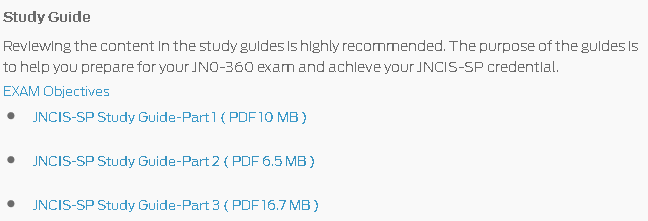Ontem realizei o exame JN0-360 da Juniper, este exame é também abrangido pelo “Fast track Program” e como tal 50% desconto se passar no assessment. Terei que aprofundar os conhecimentos em alguns dos tópicos tais como:IS-IS, Layer 2 VPNs
Pré-Requisitos
É necessário ter o JNCIA-Junos
Material de Estudo
Como material de estudo usei os documentos disponibilizados pela Juniper, para realizar o download será necessário realizar o registo no Learning Portal, este passo é importante pois o Pre-assessment que irá garantir o voucher será realizado apartir deste.
Para testar tecnologias como routing o Juniper Olive é perfeito, basicamente é um junOS virtualizado/emulado. As relacionadas com Switching/High Availability/ Layer 2/3 VPNs entre outras usei os Virtual Labs (acho que só os partners têm acesso), o único senão é que a release dos EX/MX é a 11.x e a recomendada para estudo é a 14.1.
Deixo aqui as minhas notas para download, não estão tão resumidas como gostaria….
Em suma os passos foram:
Importante:É necessário estar autenticado no Learning Portal para aceder aos conteúdos
Após autenticar, abrir Fast Track Portal, são exibidas 2 colunas, abaixo encontra-se representada a coluna da direita. Escolher os recursos de estudo “Review study resources”

Nota: Caso contenha um cadeado significa que ainda não se encontra autenticado
1. Praticar através dos 3 guides disponibilizados no Fast Track Portal

2. Day One Guides
3. Rever alguns dos Learning Bytes
4.Praticar os 2 testes de conhecimento
4.1 Practise Test
4.2 Pre-assessment Oficial (para obter o voucher)
Nota: Neste caso como realizei com sucesso aparece o resultado, mas deverá aparecer um link
Após passar o Pre-assessment Oficial, o voucher será enviado para o email registado no Learning Portal.
De seguida, agendar o Exame final em www.pearsonvue.com e usar o voucher :)
Objectivos Exame inclui:
- Protocol-Independent Routing
- Open Shortest Path First (OSPF)
- Intermediate System to Intermediate System (IS-IS)
- Border Gateway Protocol (BGP)
- Layer 2 Bridging and VLANs
- Spanning-Tree Protocols
- Multiprotocol Label Switching (MPLS) and MPLS VPNs
- IPv6
- Tunnels
- High Availability
**Clique para expandir/colapsar os objectivos em detalhe**
Protocol-Independent Routing
- Identify the concepts, operation and functionality of various protocol-independent routing components
- Static, aggregate, and generated routes
- Martian addresses
- Routing instances, including RIB groups
- Load balancing
- Filter-based forwarding
- Demonstrate knowledge of how to configure and monitor various protocol-independent routing components
- Static, aggregate, and generated routes
- Load balancing
- Filter-based forwarding
Open Shortest Path First (OSPF)
- Identify the concepts, operation and functionality of OSPF
- Link-state database
- OSPF packet types
- Router ID
- Adjacencies and neighbors
- Designated router (DR) and backup designated router (BDR)
- OSPF area and router types
- LSA packet types
- Demonstrate knowledge of how to configure, monitor and troubleshoot OSPF
- Areas, interfaces and neighbors
- Additional basic options
- Routing policy application
- Troubleshooting tools
Intermediate System to Intermediate System (IS-IS)
- Identify the concepts, operation and functionality of IS-IS
- Link-state database
- IS-IS PDUs
- TLVs
- Levels and areas
- Designated intermediate system (DIS)
- Metrics
- Demonstrate knowledge of how to configure, monitor and troubleshoot OSPF
- Areas, interfaces and neighbors
- Additional basic options
- Routing policy application
- Troubleshooting tools
Border Gateway Protocol (BGP)
- Identify the concepts, operation and functionality of BGP
- BGP basic operation
- BGP message types
- Attributes
- Route/path selection process
- IBGP and EBGP functionality and interaction
- Demonstrate knowledge of how to configure and monitor BGP
- Groups and peers
- Additional basic options
- Routing policy application
Layer 2 Bridging and VLANs
- Identify the concepts, operation, and functionality of Layer 2 bridging for the Junos OS
- Service Provider switching platforms
- Bridging elements and terminology
- Frame processing
- Virtual Switches
- Provider bridging (e.g., Q-in-Q tunneling)
- Identify the concepts, benefits, and functionality of VLANs
- Port modes
- Tagging
- MVRP
- IRB
- Demonstrate knowledge of how to configure, monitor and troubleshoot Layer 2 bridging and VLANs
- Interfaces and ports
- VLANs
- MVRP
- IRB
- Provider bridging
Spanning-Tree Protocols
- Identify the concepts, benefits, operation, and functionality of Spanning Tree Protocol and its variants
- STP, RSTP, MSTP and VSTP concepts
- Port roles and states
- BPDUs
- Convergence and reconvergence
- Spanning-tree security
- Demonstrate knowledge of how to configure, monitor and troubleshoot STP and its variants
- Spanning-tree protocols – STP, RSTP, MSTP, VSTP
- BPDU, loop and root protection
Multiprotocol Label Switching (MPLS) and MPLS VPNs
- Identify the concepts, operation, and functionality of MPLS
- MPLS terminology
- MPLS packet header
- End-to-end packet flow and forwarding
- Labels and the label information base (LIB)
- MPLS and routing tables
- RSVP
- LDP
- Identify the concepts, benefits, operation, and functionality of MPLS VPNs
- VPN routing tables
- Layer 3 VPN terminology and components
- BGP Layer 2 VPN terminology and components
- LDP Layer 2 circuit terminology and components
- Virtual private LAN service (VPLS) terminology and components
- MPLS VPN control plane traffic flow
- MPLS VPN data plane traffic flow
- Demonstrate knowledge of how to configure and monitor MPLS
- MPLS forwarding
- RSVP-signaled and LDP-signaled LSPs
IPv6
- Identify the concepts, operation and functionality of IPv6
- IPv4 vs. IPv6
- Address types, notation and format
- Address scopes
- Autoconfiguration
- Tunneling
- Demonstrate knowledge of how to configure and monitor IPv6
- Interfaces
- Static routes
- Dynamic routing – OSPFv3, IS-IS, BGP
- IPv6 over IPv4 tunneling
Tunnels
- Identify the concepts, requirements and functionality of IP tunneling
- Tunneling applications and considerations
- GRE
- IP-IP
- Demonstrate knowledge of how to configure and monitor IP tunnels
- GRE configuration
- IP-IP configuration
High Availability
- Identify the concepts, benefits, applications and requirements of high availability
- Link aggregation groups (LAG) and multichassis LAGs (MC-LAGs)
- Graceful restart (GR)
- Graceful Routing Engine switchover (GRES)
- Nonstop active routing (NSR)
- Nonstsop bridging (NSB)
- Bidirectional Forwarding Detection (BFD)
- Virtual Router Redundancy Protocol (VRRP)
- Unified In-Service Software Upgrade (ISSU)
- Ethernet Ring Protection (ERP)
- Demonstrate knowledge of how to configure and monitor high availability component
- LAG, MC-LAG
- Additional basic options
- GR, GRES, NSR and NSB
- VRRP
- ISSU
Exame
A prova tem a duração de 90 minutos com 70 questões. O minimo para passar é de 64%
Resultado
Como é hábito o resultado é provisório, mas recebi há minutos atrás o resultado final e Passei!
Para não haver dúvidas segundo o CertManager, é oficial. Agora é hora de descansar por uns dias!

Este é o logo oficial

Referências:
Juniper Fast Track
Juniper Learning Portal
Juniper JNCIS-SP
Junos documentation
Junos documentation for EX Series switches
Junos documentation for MX Series
Juniper Certificações Junho 2013
Exame JNCIA-Junos JN0-102



